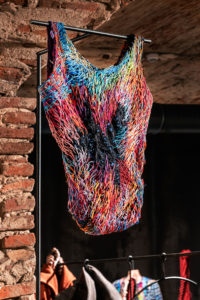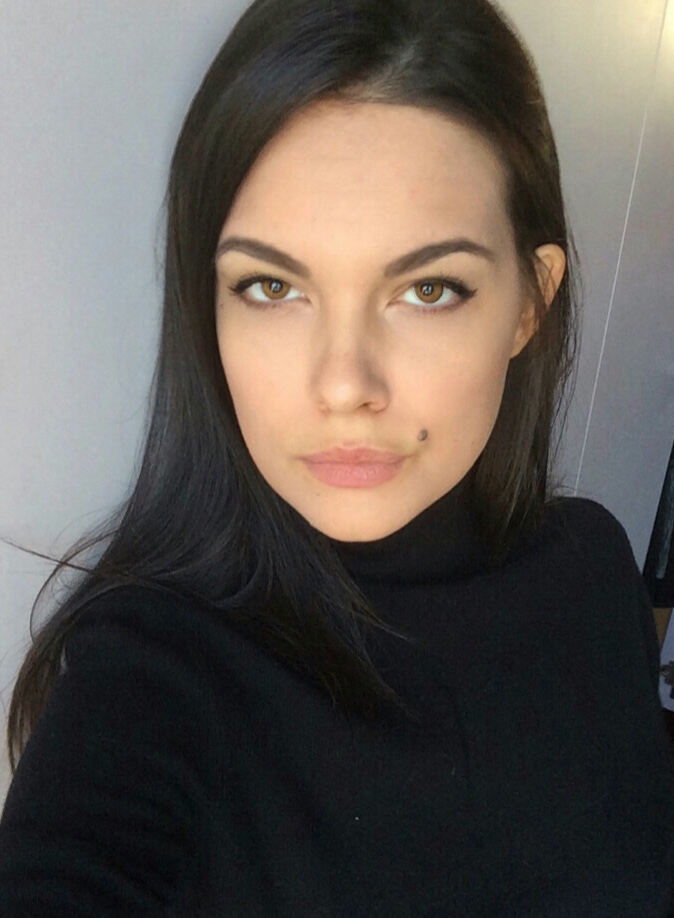Sissi (Daniela Olivieri, Bologna 1977), is an elegant artist and so her creatures, her polycentric universe, a hymn to life made of clothes, sculptures, installations and performances, to which she dedicates herself infinitely and patiently, with scientific attitude. And there is an important ambiguity between her vital and colorful world and the overflowing secretions that inhabit it, filamentous organisms produced by a consistent and very sensual manual skill. We talked with her about the Vestimenti exhibition, until April 19 in Bologna, at Palazzo Bentivoglio and which has now reinvented itself following the Italian health emergency, but also about its ceramics, its fascinations, and future projects.
Sara Cirillo: Let’s start with the Vestimenti exhibition at Palazzo Bentivoglio in Bologna: your artistic research has always put the body at the center. Without wanting to fall into the Cartesian error of opposing different instances, is it correct to see epiphanies of corporeity in the clothes and in the anatomical bowels? I refer to the lived-body, the worldized body and the anatomical one …
Sissi: Dressing is our being seen from outside. I have read medical books and I have studied tailoring patterns for years and still today I spend my time with them to always feel full of experience. Overlapping languages and learning methods gradually find common denominators, there is always a link with doing. Anatomy in Greek means to cut, open and then look inside the body like a fabric, a flap raised and folded in turn like the pages of a peeled book.
My research grows in the internal landscape of the body, with the artist’s book Parallel Anatomy since 1998 I have been writing and drawing identity in change.
The exterior changes and the interior follows it. Internal emotions are intangible organs that in the interaction with the external world find shape.
A work that goes back from the deep inside towards the surface, the skin, the envelope that contains us. Between diaries, archives and clothes I study the oscillations of the dress, an integrated element of our body. Just as the cells of our body are daily renewed, clothes change.
Dorfles said that fashion is a serious matter, while today talking about it still evokes superficial judgments. Clothes are certainly serious for you: for example, I think of the symbolic meaning of the dress in the Deposition of Antelami. Is your relationship with fashion and clothes more universal or personal and intimate?
The image of the stripped and contested garment is collected in a corner of the marble relief, projecting outwards in the form of a wave that can tip over you and bring renewal. That image became a manifesto of my thoughts and of the exhibition. When you meet a dress, you touch it and want to have it as another individual to relate to. I am fascinated by the movements we make with personal cadences in folding, hanging, cleaning, arranging, accumulating, throwing and storing objects that are close to us in closed boxes, and the clothes are the most intimate. The materials have a suggestive power, interacting in the encounter with the human being they express seduction and I have continually seen other inside the inorganic, but then what remains is the transformation that you learn to know and live through materials. The simple gesture of resuming a dress stored in a box in the cellar, grafting it into everyday life is for me to return the experience of the past to the future. It is a ritual full of transformative intent.
The exhibition is currently not open to visitors following the health emergency that is forcing Italy into a quarantine. With the curatorial staff of Palazzo Bentivoglio you have decided to opt for a different form of experience … what inspires you in these difficult days? What is the feeling that pervades you?
The house is an expansion of the body, I take care of the space and feel the benefits of this living inside me. Now more than ever I dedicate my days to jobs that require time, dedication and immobility in the company of a lounge and a terrace.
Sewing is for me an elastic gymnastics to stretch out, go out because the dress introduces us emotionally to the world. Consequently, at this moment I am not cutting and not sewing, but embroidery, patching insisting on points that accumulate on each other in a pile of projects.
With Palazzo Bentivoglio we have given the assignment to be able to go out to a wire, to a line that would plot out a journey towards everyone. The idea took shape in a series of pencil drawings on a daily basis. A diary that fits perfectly the stories of Palazzo Bentivoglio’s profile on Instagram. They appear and fade every day to dress and live our feeling now.
Let’s move on to ceramics. Your work in this sense really evokes a shapeless viscerality, a powerful physicality to a tactility that pushes the visitor near the work. How much sensuality and how much gloom is there in your relationship with this medium? You talked about “body crushed on the wall” and “nervous explosions”…
In clay I look for the missing rib. Motivi Ossei is a title that brings together all my milky-colored ceramic works. It sprouts when installed in internal spaces and is impetuous, massive when it comes out, placing itself outside to survive the environment.
Pottery is the maturity of a clay bite, pulling knotty and articulatory chains out of it. Everything for me is structure, be it clay, bones, tissues or metal skeletons, the aim is to form the disordered identity of the multiuniverse that accompanies us.
You also used ceramic for your homage to Giorgio Morandi, presented at ArteFiera by Galleria d’Arte Maggiore. What is your relationship with this historic gallery in Bologna and with the Morandian heritage?
There are different affinities that unite us like the interest in Giorgio Morandi’s work, but above all the passion for ceramics, with which I work thanks to the production support of Bottega Gatti in Faenza.
I see inside the firm matter of Morandi’s paintings a lumpy and shapeless line, because in contact with the other my nature is to reveal the vital drives in everything that surrounds me.
In the two works, a tribute to the artist entitled “Mornatura”, I represent a vase of flowers and a set of bottles on a tray. My intervention is comparable to a breath that manipulates the earth by animating Morandi’s still lifes for a moment and then crystallizing them again in the movement of returning to life.
I try to see in Morandi’s pictoriality a lumpy and formless component that I feel in my manipulation and pressure rooted with clay. In the land as in painting there is a wet and slippery birth, but also opposition to the reaction of exit as a thinned root that holds the land of origin. I always find in the work conflicting drives that learn to grow together.
One of your masters in Bologna was Renato Barilli, can you tell us more? Even compared to your training in the Academy …
I trained at the Academy of Fine Arts in Bologna where I currently teach Anatomy and Performative Techniques. These are the same subjects that I have preferred in my academic training and those with which I graduated. I started early by enrolling at the Academy at 16 and I built important references there. Renato Barilli did not teach at the Academy and therefore was not among my professors, but he contributed to my growth no less.
The knotting of the threads, the assembling of knots and the knitting is central to your artistry. Are the finished works more cages or nests?
The “Nidi” works are sculptures with shapes that recall synapses, cells, houses, clouds intertwined in bamboo and painted papers, presented for the first time in 2003 at the Macro Museum in Rome.
A significant work for me because it marks the transition from soft and plastic knitted yarns to the use of natural materials woven and structured by the weft and warp. Until then, the sculptures had always been cocoons to wear, to inhabit, places of performance. Instead the Nests are the “older brothers”, independent forms, empty sculptures, perhaps abandoned and ready to host what migrates.
The nest is built around the body by instinct while the cage is shaped by the rational mind. Creation requires investigation, the progress of thought proceeds alongside and continually responds to the change and flow of the materials with which we work.
You feel a particular fascination for archives and memory. Do you consider the archive a physical or a mental space?
The act of archiving is beautiful because it combines the physicality of management and the methodology of thinking about it. Once the archiving procedure has been set up, the continuation is natural, continuous as the flow of water in the excavated river bed. It is a repetitive gesture and the body likes routine. Giving everything a place has become a psychic practice of respect and belonging that expands from things to people. I don’t deny the obsessive side that fascinates my organized drawers, but like everything else, the important thing is that it is personal.
What are your next projects?
I am currently researching the CSAC fashion archive for a project with the University of Parma and the Manufacturing Companies of the territory on the occasion of Parma 2020 city of culture, a project that will end with an exhibition and a book in 2021. In particular in the section dedicated to drawings and fashion sketches, I selected three female identities as the starting point for the creation of three sculpture dresses thanks to the collaboration of the partner companies in the area. The protagonists of my tribute are Krizia because her work suggests me the “informed” dress of culture, Cinzia Ruggeri because she refers me to the “surreal” dress that lives in the utopian landscape and Brunetta who is not a designer in the strict sense, but a fashion illustrator who allowed a new vision of the figure of the woman in the imagination linked to the production of the sketches.
Info:
Sissi. Vestimenti
curated by Antonio Grulli
21 January – 19 April
Palazzo Bentivoglio, Bologna
www.palazzobentivoglio.org
 Sissi, You are more naked when dressed, 2011. Courtesy dell’artista
Sissi, You are more naked when dressed, 2011. Courtesy dell’artista
 Sissi, Vestimenti, 2020 (detail)
Sissi, Vestimenti, 2020 (detail)
 Sissi, Motivi ossei, 2016, installation view Palazzo Bentivoglio. Courtesy dell’artista. Foto di Ela Bialkowska
Sissi, Motivi ossei, 2016, installation view Palazzo Bentivoglio. Courtesy dell’artista. Foto di Ela Bialkowska
 Sissi, Nidi, Installation View at the artist’s studio, 2004 Collegio Venturoli, Bologna. Courtesy dell’artista
Sissi, Nidi, Installation View at the artist’s studio, 2004 Collegio Venturoli, Bologna. Courtesy dell’artista
 Sissi, Vestimenti, Installation View, 2020 Palazzo Bentivoglio. Courtesy dell’artista. Foto di Ela Bialkowska
Sissi, Vestimenti, Installation View, 2020 Palazzo Bentivoglio. Courtesy dell’artista. Foto di Ela Bialkowska

Graduated in Art History with a thesis in Philosophy on Baroque allegorism in Benjamin, I love the roaring avant-garde of the Ten and Twenties, the heuristic ability of the philosophy of art and I make my own the phrase attributed to Paul Gauguin according to which art it is plagiarism or it is revolution.






NO COMMENT